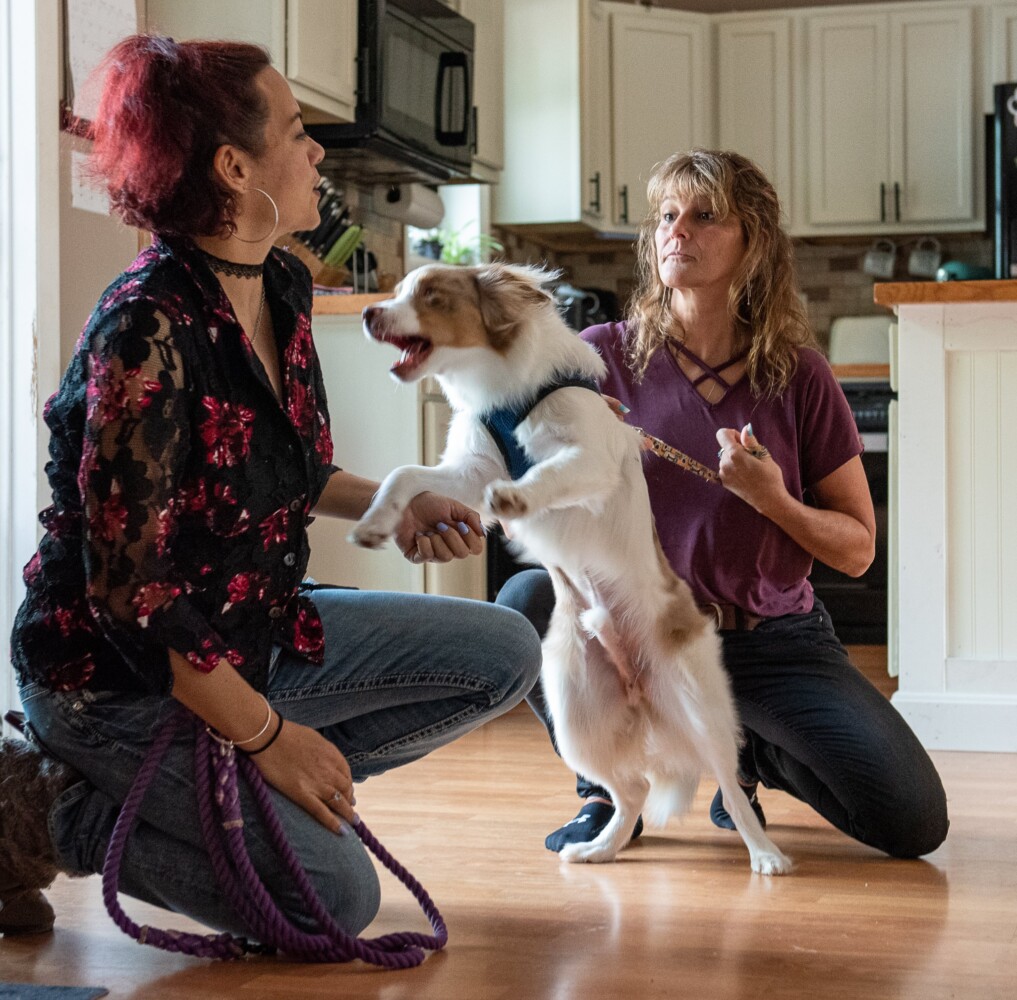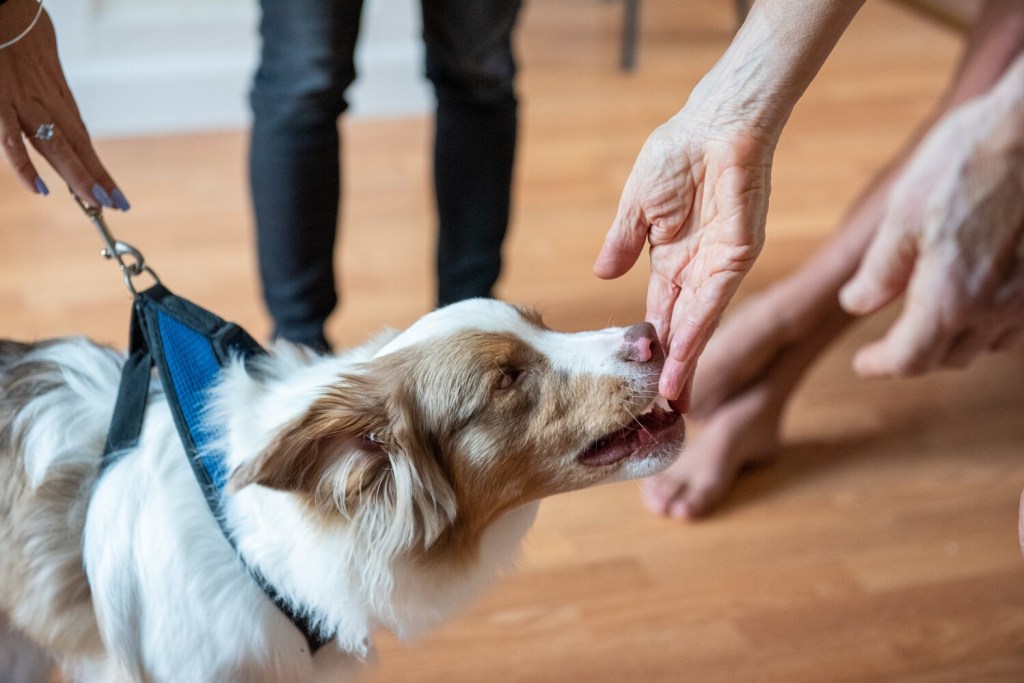Back to work. Back to school. Back to some semblance of real life. Though experts tell us COVID-19 is here for months to come, more Mainers are leaving home for the classroom, office and job site. It’s another upheaval of the pandemic — after the challenges of hunkering down for months — and is causing yet more problems many of us never anticipated, including the unwanted behaviors of our furry friends.
“I knew when the quarantine started, behavioral issues were going to skyrocket. We would be swamped by calls and some people wanting to surrender their dogs,” said Greater Androscoggin Humane Society animal behavior specialist Maria Ochs, whose job is to diagnose and humanely eliminate negative behaviors. Among GAHS’ goals is to prevent surrender whenever possible.
Typically left alone in the household during the day, or for a few hours a day, pets are accustomed to some downtime, something necessary for them and us, according to behavioral ecologist and ethologist Marc Bekoff, Ph.D., in Psychology Today. But throughout Maine’s two-month stay-at-home order earlier this year, animals had to adjust to a constant cacophony of marooned kids and parents.
Though dogs form strong attachments to their humans, unrelenting stimulation can cause them to run for cover, craving time off by hiding under a bed, behind a chair or in the farthest reaches of the yard, experts say.
And many pets’ lives are now being disrupted again by their owners’ slow return to life outside the home. This has resulted in what animal experts call displacement behaviors, manifesting in issues of separation anxiety, aggression, whining, chewing, pacing, hissing, over-grooming, jumping or growling, to name a few.
IN THE BEGINNING
Ochs moved from Wisconsin to Maine in July 2019, having previously founded a nonprofit rescue organization and acquired a variety of animal behavior certifications. These distinguish her from a trainer, who typically focuses on sit-down-stay-come and similar practices. Ochs is the first to hold the animal behavior specialist position at GAHS, the result of a 2019 grant from the American Society for the Prevention of Cruelty to Animals.
When she arrived, her primary focus was to design and implement more comprehensive behavioral assessments than GAHS had in place to thoroughly evaluate so-called “unadoptable” shelter dogs with bleak futures. Once these behaviors are better determined, the goal is rehabilitation to achieve adoption-ready status. Ochs is also building a shelter enrichment program to improve the quality of life for pets while they are there.
GAHS Executive Director Katie Lisnik said Ochs’ efforts have been extremely successful in the shelter environment. Though COVID challenges have made exact numbers indeterminate, the percentage of previously deemed unadoptable dogs going home with new owners is on the rise.
A significant aspect of Ochs’ work is that she is available to adopters to follow up with any behavioral issues once a dog leaves the shelter, including those generated by COVID-19. She also consults with families and works one-on-one with pets in the community whose owners did not adopt through GAHS, but who are struggling with problems that may result in surrender.
“We are building our capacity to be able to handle and help dogs and families we weren’t able to previously,” said Lisnik. The GAHS website features a helpline and contact information for Ochs, as well as posted seminars as they are scheduled, with GAHS offering a “yappy hour” and a variety of dog behavioral and training classes that have resumed using social distancing tools such as space-defining hula hoops.
COVID AND OAKLEY FROM OHIO
For Tammy Lynch and daughters Jessica, 17, a Leavitt High School senior, and Megan, 19, a neuro pre-med student at the University of Vermont, the onslaught of the pandemic had implications most people cannot imagine. After Jessica’s best friend died in a farm accident on July 1, 2019, and Tammy’s husband and the girl’s father died in December, the family sought to channel their grief into rescue, adopting a blind puppy named Luna in February. Then Luna died two weeks later of kidney failure.
Unwilling to give up, Tammy and Jessica drove from their home in Turner to central Ohio in March to adopt eight-week-old Oakley, a deaf mini-Australian shepherd. Once home, they realized he was also visually impaired. A week or so later the state’s stay-at-home COVID-19 order went into effect with no opportunity for Oakley to begin training classes or participate in puppy play groups —a crucial step in socialization, particularly for a severely handicapped animal.

Tammy Lynch, center, and her daughter Jessica, right, listen to Maria Ochs give instructions on how to change their approach to dealing with their dog, in order to combat his aggressive nature. Russ Dillingham/Sun Journal Buy this Photo
Problems escalated when Tammy and Megan caught the virus and were incapacitated for six weeks, resulting in a dog whose primary method of navigation was through lunging and biting the family and anyone who entered the home.
“I know he is smart,” Tammy said. “I trained him with touch signals, and within a couple of hours he learned to sit, lie down and jump up. But we have to sit on the counter to watch TV because he comes over and starts biting, sometimes breaking the skin. He can’t hear. He can’t see. He just doesn’t know any better.”
Lynch used online resources including Facebook’s blind and deaf dog training pages, and hired two trainers to come to the house after the quarantine, but nothing helped. She considered giving Oakley up to reclaim some normalcy in the household but had grown too attached; and she felt that another loss would be far too much for the family to endure.
In the interim Oakley was taken to GAHS for neutering, where Ochs entered the picture when staff could not safely remove him from his enclosure. A home consultation and one-on-one session ensued and though there’s a long road ahead, Oakley, who is also now signed up for GAHS puppy classes, is making progress.
STAY ON SCHEDULE
At the outset of Maine’s stay-at-home order, Ochs hosted a Facebook seminar on preventing COVID-generated separation anxiety and aggression in dogs, behaviors unwittingly brought on by owners who may not understand that maintaining an animal’s routine is directly related to the experience in lockdown — and after.

Brittany Linkenheimer, a certified behavior and training specialist at the Animal Refuge League of Greater Portland, with Patty, left, and Gomez in Westbrook. Cait Bourgault photo
Brittany Linkenheimer, a certified behavior and training specialist at the Animal Refuge League of Greater Portland, underscores the importance of adhering to the same pre-COVID schedule when possible.
“Dogs do best by a situational routine. For them, it’s when I get up we do this, or when a person comes over this is what happens. We want to make sure, as our lives continue to be in flux, that we are paying attention,” she said.
Linkenheimer emphasizes that if, before COVID-19, you were used to getting up and walking your dog before leaving for the office, it’s still important to get up and do it then, even though you could walk your dog later in the day now that you’re working from home.
Also, because working from home doesn’t allow for the same amount of alone time for your pet, when going out of the house, leave your dog home if they have already had their scheduled walks. That includes even going for a ride to the grocery store, she said. “Dogs could be in your car, but in quarantine it’s a better idea to give them some alone time.”
THE DOWN UNDER SIDE
In Australia, with its opposing seasons, the onset of winter caused COVID-19 numbers to swell — something predicted for the U.S. This plunged some of the country into a second lockdown in less than six months, this time from August through an anticipated Sept. 28 easing of some restrictions.
Alessina Brooks, a Melbourne, Australia, based animal behaviorist and owner of Good Dog Training Tips, said COVID-19 has presented its share of challenges for people there, with ZOOM becoming the norm during strictly imposed curfews, a one-hour time limit on outings beyond the home, and a fine equivalent to $980 U.S. dollars for exceeding nonfamily gatherings of more than two.

Alessina Brooks, an animal behaviorist and owner of Melbourne, Australia, based Good Dog Training Tips, poses with Red Dog, a Kelpie who has since passed away. Supplied photo
“Most of the calls I am getting (about pets) are about misbehaving,” she said. “But I think people used to tolerate these behaviors more because they were at work and engaged in other things. Now that they were home 24/7, all of a sudden they have to pay more attention to it. Maybe the dog isn’t misbehaving any more than she’d normally misbehave, but it’s just more evident.”
For Brooks, respect factors significantly into her work. Though considered social animals, dogs definitely need space, she said, just as humans do. “Overloading their space — such as the constant stimulation during a lockdown — can bring about stress-related behaviors. If we don’t respect dogs, how can we expect them to respect us?” she said.
Brooks also teaches people about their own “energetic space” during the pandemic or otherwise. “If you’re really uptight, depressed, unhappy, your dog’s going to pick that up. They’re going to perceive you as a kind of weak energy. They’re going to try and get ahead of you and be in charge. They’re going to try and look after you, and that’s where problems start coming in. They’ll start guarding and protecting you.”
GAHS’ Ochs has seen her share of guarding and protecting issues, before and during the stay-at-home order. The behavior is known as territorial or barrier aggression, and when dogs with such tendencies are allowed to sit in windows as people pass by, the behavior can intensify — something that happened with recently adopted GAHS shelter dog Mikey.
For Mikey, it was excessive barking — at first. Since people were home and gyms closed during the quarantine, Mikey’s new owners first saw his exploding territorial behavior when foot and bike traffic increased. When he progressed to biting someone, surrender seemed like the strongest option for the saddened owners. Working one-on-one with Mikey, however, Ochs was able to change the behavior entirely and Mikey now even goes out canoeing with his owner.
PET PRESENT AND FUTURE
Whether or not Maine returns to lockdown this winter, Linkenheimer in Portland says that among the shelter’s goals in serving the community is being proactive — getting ahead of a problem. Shelter resources, available on the website, include humane education programs and training and behavioral classes.
“There’s a lot of information out there with the best of intentions, but it isn’t always accurate since each case is really unique, just like the animals,” Linkenheimer said. She said the shelter’s website features a form that pet owners can fill out to begin determining the best course of action for a behavioral or training issue, which is then facilitated by the department.
“We’re definitely here for the community, trying very hard so people don’t get to the point where they’re debating about surrendering their animal.”
Send questions/comments to the editors.









Comments are no longer available on this story